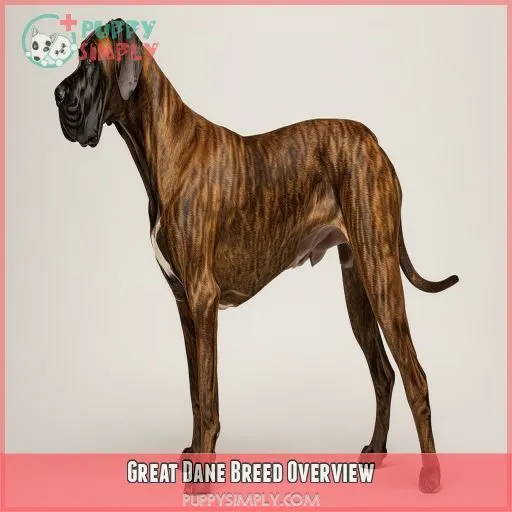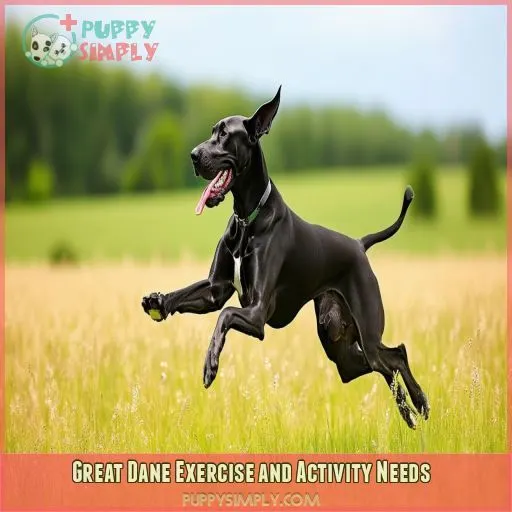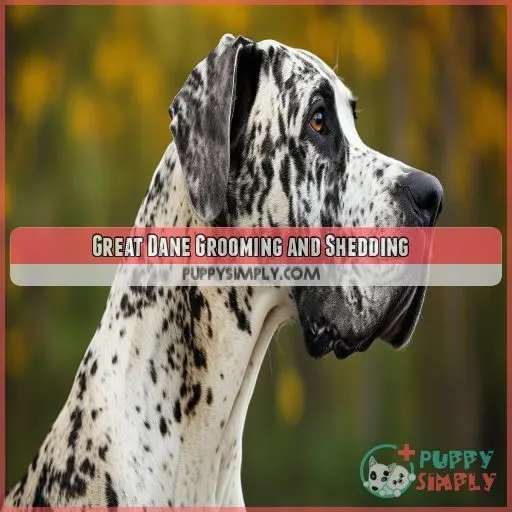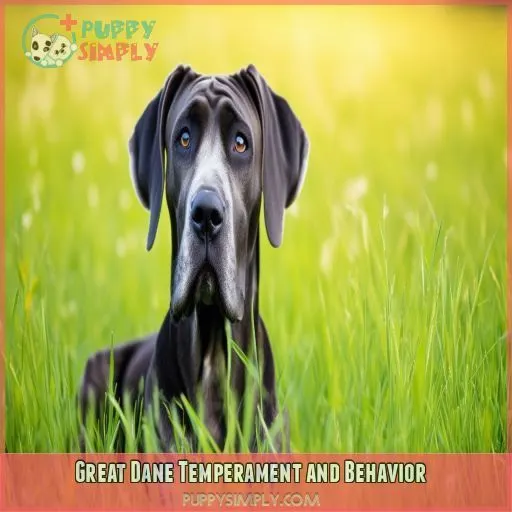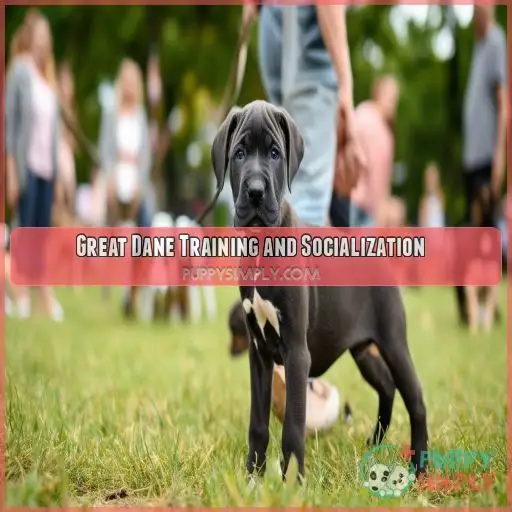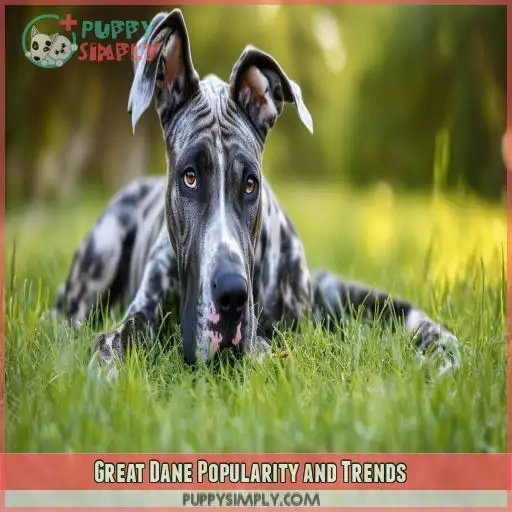This site is supported by our readers. We may earn a commission, at no cost to you, if you purchase through links.
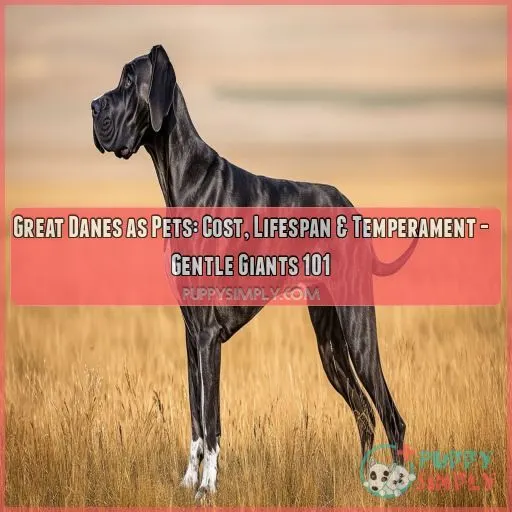
The price would be pretty manageable if you plan ahead of time, as the average life expectancy is only about 8-10 years, and most Great Danes are wonderfully gentle but protective.
Here is a guide that gives you essential insights into how to raise one of these beautiful dogs by addressing cost, health, and behavior so that you are well-prepared for this rewarding journey
Table Of Contents
- Key Takeaways
- Great Dane Breed Overview
- Great Dane Lifespan and Health Concerns
- Great Dane Cost of Ownership
- Great Dane Exercise and Activity Needs
- Great Dane Grooming and Shedding
- Great Dane Temperament and Behavior
- Great Dane Training and Socialization
- Great Dane Feeding and Nutrition
- Great Dane Housing and Space Requirements
- Great Dane Popularity and Trends
- Frequently Asked Questions (FAQs)
- What is the most common cause of death for a Great Dane?
- Are Great Danes good house dogs?
- What is a Great Dane life temperament?
- Are Great Danes high or low maintenance?
- Do Great Danes have a shorter lifespan?
- Are Great Danes good family dogs?
- Are Great Danes healthy?
- How much does it cost to keep a great dane?
- What are Great Danes sleeping habits?
- Are Great Danes suitable for apartments?
- How much do Great Danes shed?
- What are common behavioral issues?
- Do Great Danes make good therapy dogs?
- Conclusion
Key Takeaways
- Great Danes are big on love and loyalty, but their lifespan is relatively short at 8-10 years.
- They’re gentle giants with a low energy level, making them great house dogs.
- Owning a Great Dane comes with manageable costs, but be prepared for potential health issues.
- These gentle giants have a shorter lifespan, but with proper care and lots of love, they’ll be your loyal companion for many years to come
Great Dane Breed Overview
You’ll find that Great Danes have a rich history dating back over 400 years, originating in Germany as hunting dogs for boars. These gentle giants are known for their massive square-jawed heads, elegant body lines, and short coats in various colors, standing as the tallest working breed with heights of 28-32 inches and weights of 110-175 pounds
History and Origin
You might be surprised to learn that the Great Dane‘s name is a bit of a misnomer. These gentle giants actually hail from Germany, not Denmark!
Originally bred for boar hunting over 400 years ago, Great Danes have since evolved into beloved companions.
Recognized by the American Kennel Club in 1887, this breed’s popularity soared with the debut of Scooby-Doo in 1969, cementing their place in pop culture
Physical Characteristics
You’ll be amazed by the Great Dane’s impressive stature. These gentle giants are the tallest working breed, standing 28-32 inches at the shoulder and weighing 110-175 pounds. Their short coat comes in various colors, including:
- Black, fawn, and brindle
- Blue-gray and harlequin
- Mantle (black and white)
With a massive square-jawed head and elegant body lines, Great Danes are a sight to behold. However, their size comes with health concerns, affecting their 7-10 year life expectancy
Temperament and Personality
You’ll find Great Danes are gentle giants with a temperament that complements their impressive stature. They’re known for their intelligence, loyalty, and adaptability. While they can be stubborn at times, their affectionate nature makes them excellent family companions. Here’s a quick overview of their key personality traits:
| Trait | Description | Care Needs |
|---|---|---|
| Affection | Friendly and loving | Regular interaction |
| Intelligence | Quick learners | Mental stimulation |
| Exercise | Moderate needs | Daily walks |
Great Dane Lifespan and Health Concerns
Great Danes typically live 8-10 years, which is relatively short for dogs. You’ll need to be aware of their susceptibility to health issues like bloat (GDV), hip dysplasia, and dilated cardiomyopathy, emphasizing the importance of responsible breeding practices and proactive veterinary care
Average Lifespan of 8-10 Years
You will note that Great Danes live for 8-10 years, which is pretty short for dogs of their magnanimity. Here are three main steps to help your gentle giant live out his golden years:
- Responsible breeding and hip dysplasia testing
- Obesity reduction by proper diet and exercise
- Preventive care: supplements for joints, regular check-ups
Prone to Bloat (GDV), Hip Dysplasia, and Dilated Cardiomyopathy
While Great Danes typically live 8-10 years, they’re prone to serious health issues.
Bloat (GDV) is a life-threatening emergency where the stomach twists, cutting off blood supply. Hip dysplasia can cause pain and lameness, while dilated cardiomyopathy affects heart function.
You’ll need to be vigilant about bloat prevention, consider hip dysplasia testing, and watch for signs of heart problems.
Joint supplements and a healthy diet can help support your gentle giant’s well-being
Importance of Responsible Breeding and Preventative Care
You can improve the health and life expectancy of your Great Dane by breeding responsibly and observing preventative care. Here is what you need to concentrate on:
• Genetic testing to screen for hereditary conditions.
- Bloat prevention strategies, including proper feeding habits
- Partake in the regular exercise and weight management
• Joint supplements and monitoring of health regarding the thyroid
Great Dane Cost of Ownership
When considering a Great Dane as a pet, you’ll need to account for both initial and ongoing costs. These expenses include the purchase price, supplies, training, food, veterinary care, and grooming, as well as potential health issues that may arise due to the breed’s susceptibility to certain conditions
Initial Costs: Purchase Price, Supplies, Training
If you’re considering getting a Great Dane, prepare to face significant upfront expenses. These gentle giants will cost you $1,000 to $3,000 for a purebred puppy.
Then there’s the cost of basic supplies—a large crate, sturdy leash, spacious bed—and training costs, which can quickly add up, especially if you’re looking into socialization classes.
Spaying/neutering and pet insurance are important investments in your Great Dane’s health and peace of mind
Ongoing Costs: Food, Veterinary Care, Grooming
After the initial investment, you’ll also have continuous expenses with your German Boarhound.
Food bills may be high since they can be huge. Regular vet visits and preventive care might turn out expensive, especially for thyroid problems. You can invest in health insurance to take care of unexpected costs.
Grooming costs are pretty low; however, brushing is done regularly.
Remember that by investing time in your Great Dane’s care, you won’t only have a happy but also a healthy companion dog that’s known for being kind
Budgeting for Potential Health Issues
When owning a Great Dane, you’ll need to budget for potential health issues. To protect your gentle giant and your wallet, consider:
- Investing in veterinary insurance
- Setting up an emergency fund
- Creating a dedicated pet savings account
- Scheduling regular health screenings
These precautions can help manage costs for common Great Dane health concerns. Remember, your grand danois may be a protection dog, but it’s up to you to protect their health and your finances
Great Dane Exercise and Activity Needs
You’ll need to provide your Great Dane with at least an hour of daily exercise to maintain their health and prevent obesity-related issues. It’s important to be mindful of extreme temperatures during outdoor activities, as these gentle giants can be sensitive to both hot and cold weather
Require at Least an Hour of Exercise Daily
After considering the costs, you’ll need to factor in your Great Dane’s exercise needs. Despite their size, these gentle giants require at least an hour of daily activity. Here’s a breakdown of their exercise requirements:
| Activity Type | Duration | Impact |
|---|---|---|
| Walks | 30-45 min | Moderate |
| Playtime | 15-20 min | High |
| Training | 10-15 min | Low |
| Indoor games | As needed | Low |
| Rest periods | Frequent | Essential |
Importance of Proper Exercise to Maintain Health
Proper exercise is instrumental to your Great Dane’s health. You need to get him into a routine consistently based on both frequency and intensity.
Daily walks, high-energy frolics in a strongly fenced-in yard, or dates with other dogs at the local dog park will keep your giant nice and limber.
There’s no special equipment involved, but you’ll require a good leash and collar that won’t pop under his massive neck.
This regular exercise will keep them from becoming obese, strengthen their joints, and generally enhance their health throughout their majestic lifetime
Sensitivity to Extreme Temperatures
You’ll find that Great Danes aren’t particularly weather tolerant. Their short coats offer little protection against extreme climates.
In hot weather, they can quickly overheat, while cold temperatures make them shiver. Keep an eye on your gentle giant’s heat tolerance and cold tolerance.
Provide shade and water on scorching days, and consider a cozy sweater for chilly walks. Temperature sensitivity is key to your Dane’s comfort and safety
Great Dane Grooming and Shedding
Great Danes are moderate-to-heavy shedders, particularly during seasonal shedding periods, which means you’ll need to commit to Regular grooming to manage their coat. You’ll want to establish a consistent bathing and brushing routine to minimize shedding and keep your Great Dane’s short coat in good condition, but be aware that this breed isn’t considered hypoallergenic
Moderate-to-heavy Shedders, Especially During Shedding Seasons
While they need regular exercise, a Great Dane is known for his tendency to shed. You’ll like your gentle giant, who can be a moderate to heavy shedder, especially during seasonal changes. To handle all the excess shedding, consider:
- Daily brushing during high shedding seasons
- Use a de-shedding tool once a week.
- Balanced Nutrition for Maintaining Healthiest Coat
- Invest in an excellent vacuum cleaner.
These strategies for coat care won’t only minimize the amount of hair throughout your home, but they’ll also help to keep your Dane looking his best.
Regular Bathing and Grooming Needed to Minimize Shedding
This means you must consent to frequent grooming for your Great Dane. Their coats might be short but do require weekly brushing—not for reasons of maintenance, as it would seem—but more to control shedding and spread those excellent natural oils throughout their coats.
Bathe your gentle giant every 6-8 weeks with dog-specific shampoos. Such a regime won’t only help reduce shedding but also keep the coat healthy, regardless of its color.
This is at a low cost compared to long-haired breeds but high in the magnitude of shedding
Not Considered Hypoallergenic
If you have allergy issues, know that Great Danes aren’t hypoallergenic. They produce pet dander and shed a lot, to a moderate degree. This can help trigger allergies in people, whereupon controlling shedding would come of use, but this alone won’t fix the problem. You have to, therefore, opt for hypoallergenic alternatives if these allergies are acute. Some home cleaning techniques, though, will help:
- Regular vacuuming using a HEPA-filter vacuum
• Running an air purifier inside your home
- Washing your Great Dane’s bedding weekly
Great Dane Temperament and Behavior
Great Danes are known for their gentle, sweet, and affectionate nature, making them excellent companions for families with children and other pets when properly socialized. However, their protective instincts and territorial tendencies can emerge if not addressed through early training, emphasizing the importance of consistent socialization and positive reinforcement from a young age
Gentle, Sweet, and Affectionate
You’ll find Great Danes to be gentle giants with hearts of gold. Their affectionate nature shines through in every interaction. Despite their imposing size, they’re known for their sweet temperament. Here’s a quick overview of their personality traits:
| Trait | Description | Historical Context |
|---|---|---|
| Gentle | Calm and patient | Bred for companionship |
| Sweet | Loving and kind | Evolved from hunting dogs |
| Affectionate | Enjoys cuddles | Developed as family pets |
| Loyal | Devoted to family | Protective instincts remain |
Good With Children and Other Pets When Properly Socialized
Although Great Danes are huge, they’re sometimes very gentle with children and other pets. Their sweetness extends to the entire family if socialization has been done right. Try these socialization techniques to help make your Dane a well-adjusted pet:
Introduce them to various people, animals, and environments early.
- Arrange playdates with friendly dogs of different sizes
Gradually expose them to children’s noise and movements.
• Practice handling exercises that simulate vet visits
- Positive reinforcement in new experiences
These steps help create a pet-friendly home and foster positive family dynamics
Can Be Protective and Territorial, Requiring Early Training
While Great Danes are known for their gentle nature, they have territorial behaviors. You’ll want to start training very early to ensure your gentle giant doesn’t become overprotective.
Their suitability for families requires proper socialization. With the right approach, you can harness this guard dog’s potential without ruining their friendly character.
Remember that shaping the protective instincts of a Dane into something positive requires consistency
Great Dane Training and Socialization
The Great Danes are easy to train because they desire to please their owners. Early socialization might prevent cases of possible aggression as they mature. However, consistency in training methods and positive techniques guarantee their mature stage into well-mannered gentle giants.
Easy to Train Due to Innate Desire to Please
You will find it easy to train Great Danes simply because they’ve that innate disposition to please. Their intelligence and readiness to learn make them responsive to various training methods. Here’s a way you can effectively train your gentle giant:
- Positive reinforcement and motivation strategies
- Clicker training for precision of commands
- They may require some patience with housebreaking issues due to size.
You will be able to develop strong bonds with your Great Dane through consistent training sessions and subdivisional interchange of clear communication, which will grow up to be well-behaved companions.
Importance of Early Socialization to Prevent Aggression
Early socialization is essential for the development of your Great Dane. From an early age, socializing your gentle giant with different people, animals, and places will help prevent aggression later in his life.
Responsible breeding also plays a part—well-bred Danes often have much better temperaments.
With all this concern about socialization, one can sometimes forget other aspects of their care, such as bloat management and joint supplements for overall health and happiness
Consistency and Positive Reinforcement Key to Successful Training
Building on the early socialization, you’ll undoubtedly find that consistency and reward are instrumental in the training of your Great Dane. Reward good behavior without harsh corrections, and stick to a routine by praising your giant for following through with commands.
This approach not only prevents aggression but also strengthens bonding. Remember that patience and kindness can make all the difference in the training journey of a Great Dane
Great Dane Feeding and Nutrition
You’ll need to carefully manage your Great Dane’s diet to prevent excessive growth and obesity, which can strain their joints and increase health risks. Feeding multiple small meals throughout the day, rather than one or two large ones, can help reduce the risk of bloat, a potentially life-threatening condition in large breeds
Proper Diet to Prevent Excessive Growth and Obesity
To ensure that your Great Dane keeps fit and healthy, there are some diet recommendations worth following.
- Balanced Diet: Ensure high-grade, protein-rich foodstuff for the dog.
- Weight Management: The weight should be checked regularly to avoid obesity.
- Nutritional Supplements: Add glucosamine and chondroitin sulfate for joint health.
- Feeding Frequency: Maintain a consistent feeding schedule with servings appropriate to age and activity level.
Importance of Multiple Small Meals to Prevent Bloat
Feeding your Great Dane multiple small meals daily is essential for bloating prevention. Spread out their food intake to avoid stomach twists, a potentially fatal condition. Maintaining consistent meal frequency helps keep them healthy.
| Category | Single Meal | Multiple Meals |
|---|---|---|
| Benefit | Higher bloat risk | Lower bloat risk |
| Digestion | Overwhelmed | Steady |
| Energy | Spikes | Balanced |
| Health | Risky | Safer |
Nutritional Needs Change Throughout Lifespan
As your Great Dane grows, their nutritional plan needs adapting. Puppies need a balanced diet to prevent rapid growth, avoiding joint issues. Adults require dietary adjustments for sustained energy and weight management. Seniors benefit from a specialized diet to support aging joints and metabolism.
3 essential tips:
- Regular vet checkups for growth monitoring
- Implement a senior diet for older dogs
- Lifelong care equals a better life
Great Dane Housing and Space Requirements
Great Danes take up much space at home to sleep and stretch, so their surroundings should be spacious for comfort. You’ll also want a large vehicle to drive around in, with a securely enclosed yard and tall fence so that they’ve a safe area outdoors.
Need Plenty of Space for Sleeping and Stretching
Great Danes prefer to have ample sleeping and stretching space. Roomy quarters, a bed that gives it space to stretch its massive size. Sleeping comfort is ensured with a large crate that will allow them to lie flat without any confinements. Satisfactory stretching maintains their physical health and keeps them away from potential joint problems for health and fitness.
Require a Large Vehicle for Transportation
A Great Dane will call for a large vehicle. Their size can’t fit in small cars, therefore presenting transportation issues, more so in urban living. Ensure your vehicle is big enough to accommodate them comfortably for their safety and comfort.
- Use an SUV or a van
Allow for adequate legroom and cargo space.
- Secure them with appropriate restraints to prevent accidents
Importance of Secure, Enclosed Yard With High Fence
Great Danes need a secure yard with a high fence to prevent escapes due to their size and agility. Their safety and well-being depend on an enclosed space where they can stretch and play. Given their size, a large vehicle is essential for transportation. Ensuring a secure, enclosed yard helps maintain their health, security, and happiness
Great Dane Popularity and Trends
Because they’re so gentle, yet imposingly large, Great Danes have long had some popularity, especially in the southern US. This surge was notably boosted by the arrival of the Scooby-Doo franchise in 1969, transforming big dogs into pop-culture icons.
Particularly Popular in Southern States of the US
Great Danes enjoy significant popularity in the southern states of the US. The breed’s easygoing temperament and affectionate nature make them a great match for the warm, welcoming culture found there. You’ll find that these gentle giants thrive in the spacious homes and larger yards common in southern regions, making them an ideal pet for families seeking loyal companionship
Popularity Surged After Scooby-Doo Franchise Debut in 1969
The Scooby-Doo influence on Great Dane popularity is undeniable. When the franchise debuted in 1969, it catapulted the breed into the 1960s pop culture spotlight. Despite being a German breed, not Danish as the name suggests, this ‘gentle giant’ quickly became a household name, boosting its appeal and accelerating its adoption rates in countless homes
Frequently Asked Questions (FAQs)
What is the most common cause of death for a Great Dane?
The most common cause of death for Great Danes is gastric dilatation-volvulus (GDV), a condition where the stomach twists, cutting off blood flow and leading to a rapid, life-threatening situation requiring immediate veterinary attention
Are Great Danes good house dogs?
Yes, Great Danes can be good house dogs due to their gentle nature, low energy level, and affectionate temperament. However, you’ll need plenty of space and regular care to accommodate their large size and health needs
What is a Great Dane life temperament?
Imagine a gentle giant towering in grace, that’s a Great Dane. They’re affectionate, low-energy, and easy to train. These loyal protectors make excellent companions, offering a blend of warmth and watchfulness to your home
Are Great Danes high or low maintenance?
Great Danes are generally low maintenance. They require minimal grooming and average exercise but need a spacious living area and can have significant health issues that demand attention. Regular vet visits and appropriate care are essential
Do Great Danes have a shorter lifespan?
Unfortunately, Great Danes do have a shorter lifespan compared to smaller dog breeds. Their average life expectancy is just 8-10 years, which is quite low for a large breed. Proper care and preventative health measures can help extend their longevity
Are Great Danes good family dogs?
Think of a gentle giant watching over a village, embodying Great Danes’ family-friendly nature. They’re affectionate, great with kids, and protective. Despite their size and drooling, their loving temperament makes them excellent family companions
Are Great Danes healthy?
Great Danes face health challenges. They’re prone to bloat, hip dysplasia, and cardiomyopathy. Regular vet checkups, a balanced diet, and proper care can mitigate risks. These gentle giants need attentive management to enjoy a healthy life
How much does it cost to keep a great dane?
Keeping a Great Dane can cost approximately $2,000 to $3,000 annually, covering food, medical care, grooming, and miscellaneous expenses. Initial costs, including adoption, supplies, and possible training, can range from $1,500 to $3,000
What are Great Danes sleeping habits?
Like a gentle titan finding solace under a shaded oak, Great Danes sleep soundly, needing a large, comfortable space. They typically snooze for 12-14 hours a day, maintaining low energy and enjoying their rest peacefully
Are Great Danes suitable for apartments?
Great Danes aren’t ideal for apartments due to their large size and space needs. They require ample room to stretch and move. However, with sufficient exercise and space, they can adapt to apartment living
How much do Great Danes shed?
Great Danes shed moderately year-round, with increased shedding during seasonal changes. Their short coat requires regular grooming, including weekly brushing and occasional bathing, to manage shedding and maintain healthy skin and coat
What are common behavioral issues?
Great Danes commonly face behavioral issues like chewing, separation anxiety, and excessive barking. These big, bashful beauties need early socialization, consistent training, and mental stimulation to curb such problems and cultivate a calm, content companion
Do Great Danes make good therapy dogs?
Yes, Great Danes make good therapy dogs. Their gentle, friendly nature, along with their calm demeanor, allows them to offer comfort and emotional support effectively. However, their large size requires careful handling and space considerations
Conclusion
Imagine bringing home a gentle giant named Max, who’d envelop your house with love and loyalty.
As you learned, the requirements of having a Great Dane as a pet include specific needs concerning cost, life expectancy, and temperament.
With proper planning, an owner can look forward to an enriching experience consisting of quite manageable expenses, a healthy span of 8-10 years of life, and a loving but protective companion.

